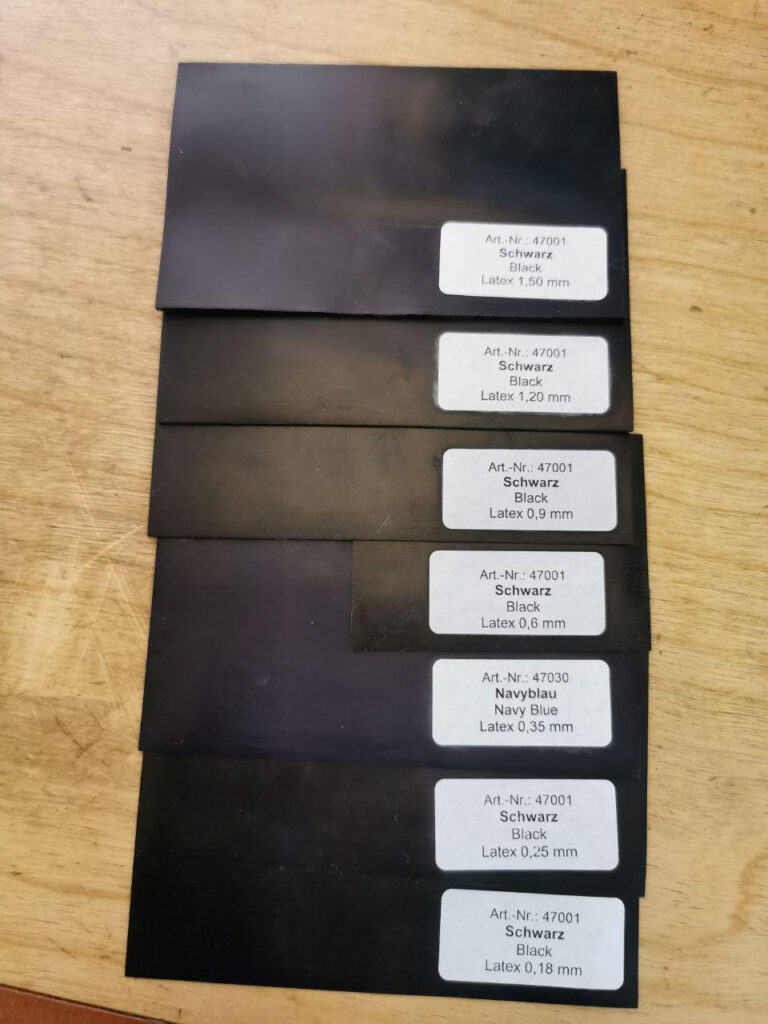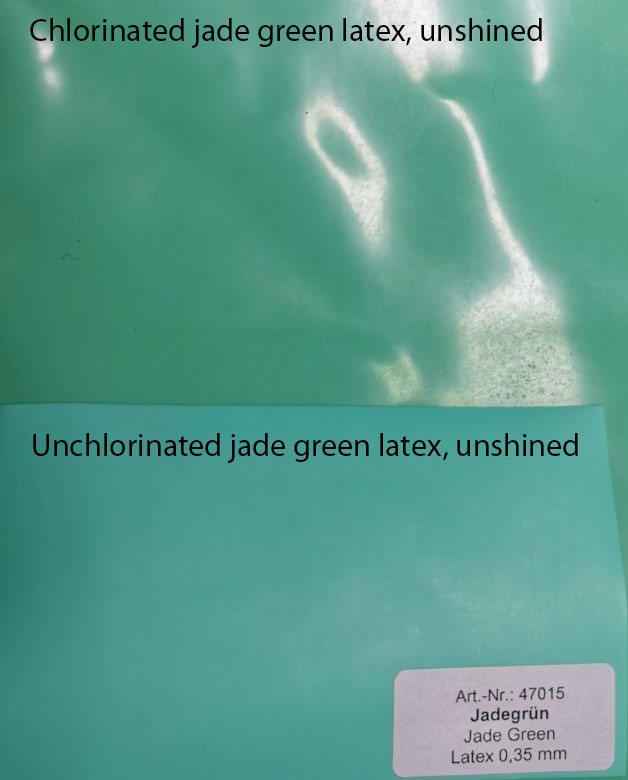So, you’re ready to order latex? Maybe you’ve seen all those fun ‘shiny poodle’ photos on Twitter, or maybe you’ve touched or tried on another person’s latex suit. In any case, there are a few things to know before ordering your first suit.

Where should I order my suit from?
There are many things to consider when ordering a suit. A well-made, well-taken-care-of latex suit can last years and provide a lot of enjoyment.
This is not going to be an exhaustive list, but is based on my experience and others.
Latex Catfish – http://www.latexcatfish.com
Located in China, Latex Catfish is probably the company that most furries use. For casual wearers, they may be acceptable. There’s been some confusion between the Chinese version of Latex Catfish and the US version — at this time it is not entirely clear which company will fulfill your order. Regardless, it will be made in China.
Consider these pros and cons:
Pros
- Low prices – due to being made in China, Latex Catfish’s prices are often half of what other companies charge.
- Custom designs, including inflatable sections – LCF can make a full custom design, including inflatable tails.
- Custom sizing is available – For 20% extra, LCF will custom size your suit. But see below.
Cons
- Language barrier – Sometimes, working with non-native English speakers can result in embarrassing mistakes.
- Long wait times – It’s not uncommon for suits to take more than 6 months to get to you.
- Custom sizing is not always a good fit – LCF seems to have trouble with larger North American / European bodies, and often the arms are much too tight and don’t offer a good range of motion. There are also many stories of massive errors being made in the suit, despite correct sizes being sent.
- Lower-quality latex – LCF’s latex is not as high-quality as some European makers.
- Terrible support – I’ve been told by friends that LCF is really bad when you have a problem with your suit. Also, you’d have to ship it back to China, which can be expensive and take a long time. With no tracking, they apparently also claim that they never received it.
Verdict: Order from LCF if you don’t mind waiting, don’t mind a possibly tight fit, and are on a budget. But I don’t recommend it
Kink Engineering – https://kinkengineering.com/
As of 2021, Kink Engineering, the only maker on this list based out of North America, has started doing custom catsuits, beginning with their KickStarter.
Pros
- Known for their vac beds, Kink Engineering has been in the latex industry for a long time.
- Catsuits are made-to-measure and fit incredibly well
- Being in North America makes shipping more easy. If you’re in the Toronto area, local pickup is also available.
- Fully custom work is possible (gallery to come)
Cons
- As they are a boutique maker, Kink Engineering will be more costly than most other options
- Fully custom “latex fursuits” will be open only at some times of the year
- Due to the length of the queue, completion times can be long
Verdict: Kink Engineering is absolutely wonderful if you have a large budget and are willing to wait for quality.
Invincible Rubber – https://www.invinciblerubber.com
Based out of the UK, Invincible Rubber is a more traditional latex store that focuses on a wide variety of clothing items.
Pros
- Excellent workmanship – Invincible’s seam quality and workmanship is second to none.
- Excellent latex quality – Invincible uses top-quality latex. It looks and feels superior to Chinese latex.
- Reasonable pricing – Pricing for a simple single-color catsuit is $200 USD, which is quite affordable.
Cons
- Custom sizing costs extra – Invincible charges 120 pounds to create a custom pattern. However, once created, it can be used many times.
- No custom patterns – Invincible is not really able to do custom patterns, without charging a bunch of money.
- No inflatables – Inflatable tails and accessories are also not really available.
Verdict: Order from Invincible if you want just a simple basic single-color suit and fit one of the standard sizes.
Blackstyle – https://www.blackstyle.de
Based out of Berlin, Germany, Blackstyle is one of the oldest names in latex and has been around for a long time. Their store in Berlin is a sight to behold and they stock many items, as well as do custom work.
Pros
- Excellent workmanship – Blackstyle’s workmanship is top quality
- Excellent latex quality – Blackstyle uses 4D latex; some of the best latex money can buy.
- Large stock – A large amount of items are kept in-store in Berlin and can be shipped immediately.
Cons
- Custom work is untested -I’ve never ordered a completely custom project from Blackstyle so I’m not sure what their process is. This page may be updated with other customers testimonials
- Pricing is higher – Blackstyle charges a bit more. A basic catsuit costs about $300 USD.
Verdict: Order from Blackstyle if you like what they have in their catalog. Not necessarily the best for custom work.
Fantastic Rubber – https://www.fantasticrubber.de/
Also based out of Berlin, Fantastic Rubber specializes in custom-fit neck-entry suits made to order.
Pros
- Custom sizing is standard – Fantastic Rubber will measure you in-person, in their Berlin studio, for free.
- Incredible Fit – As a result of the in-person measuring, the suit fits incredibly well, better than any I’ve ever had.
- Custom patterns possible – FR can work with your custom body designs and create them.
- Inflatables maybe? – I’m not sure, but I have seen them do some inflatable tails.
- 2-year warranty – FR will repair the suit for two years, free.
Cons
- Workmanship is mediocre – Despite putting in reinforcements, Fantastic makes their suits in a way that seems to result in many tears and issues. It is unclear what the cause of this is, but it seems to be a common problem with FR suits.
- Neck Entry can cause issues – Since FR almost exclusively creates neck entry suits, it puts a lot of stress on the neck and will result in more tears.
- Not everyone can go to Berlin – I am not sure if the custom measuring is available if you are not able to go to Berlin.
- Owner has questionable views – The owner of Fantastic Rubber, a man named Peter Pick, is a politician for the “Alternative for Germany” (AfD) party, a right-wing party with openly fascist members. More info here.
Verdict: Order from Fantastic if you want a custom suit that fits incredibly well, but I recommend getting a rear zip to avoid the suit tearing too early.
Other makers, like Libidex, Skintight Rubber, etc not mentioned here as they are too similar to Invincible/Blackstyle/etc. If you feel they deserve a full write-up, shoot me a message!
Is there a maker you like missing from this list? Let me know!

What thickness latex should I order?
Latex comes in a variety of thicknesses. Each thickness has its own pros and cons. Generally, thinner latex will stretch more but also tear more easily, while thicker latex is stronger but provides less range of motion, since it doesn’t stretch as much.
Latex thickness is measured in millimeters (mm).
- 0.25mm and under: This is incredibly thin, about as thin as a disposable latex glove. If you have a custom suit made in this thickness, it will feel absolutely incredible, but can tear just by looking at it wrong.
- 0.35mm to 0.45mm: A good middle ground, this is what most suits are made out of. Good stretch, good strength, a good balance between “that tight feeling” and “still able to move”.
- 0.60mm: Starting to get a bit thicker here. Still fairly stretchy, but you may find your range of motion reduced when wearing a tight suit.
- 0.90mm and greater: Now you’ve getting into the “heavy rubber” stuff. Maybe you really like a very tight, enclosed feeling, or not being able to move. But I wouldn’t recommend this for tight-fit suits. If you are getting a loose-fit suit, such as a boiler suit or “hazmat” suit, this thickness is fine.
Verdict: For 90% of people, 0.35mm to 0.45mm is the range you should stay in.

Should I have my latex Chlorinated?
Chlorination is a chemical process that involves chlorine ions bonding to the polymer chains of the latex material. It is a one-way process and generally can’t be reversed.
The result of chlorination is that the latex is smoother to the touch, less grippy, and has a more dull look. But there are a few things to know about chlorination:
Pros
- Extremely smooth – Chlorinated suits feel incredibly smooth and are super fun to touch.
- Somewhat shiny without shiner – Chlorinated latex can be somewhat shiny, even without any silicone shiner applied.
- Wear without lube or talc – You can put on even a tight-fitting chlorinated suit without using silicone lube or talcum powder.
Cons
- Easier to tear – Since you are not putting in any lube when donning the suit, there is nothing to help the latex if it catches on your fingernail.
- Less stretch – Due to the nature of the chlorination chemical process, the polymer chains of the latex material become slightly less stretchy.
- No high gloss – Although chlorinated suits can be somewhat shiny without any shiner, they don’t really take to being shined with silicone shiner.
- Discoloration of lighter colors – Light colors, such as white, will become more of a yellow/brown after chlorination. See how the jade green latex above looks browner.
- Harder to repair – Chlorinated latex doesn’t take well to rubber cement, so tears can be much harder to repair.
- May stick to skin – You’ll still sweat in a chlorinated suit, and since you didn’t put any silicone lube in it, it will stick to your skin in an uncomfortable way.
Verdict: I recommend chlorination for loose-fit items, such as jackets, trousers, and jogging suits. I don’t recommend chlorination for your first latex suit.
Keep in mind, you can always have your suit chlorinated later — but you can’t undo it.

What’s the best choice for entry?
Latex suits can be put on in many different ways. From all-round zips, to neck entry, there are a bunch of options. Let’s explore each one here:
- All around zip – This is probably the most common zipper type. The zipper begins at your navel, goes down through the crotch, and then all the way up the back to the neck. It makes the suit easy to don, and allows full front and rear access. However, zippers don’t stretch, so you will find that when you bend over, the zipper will “pull tight” through your crotch in an uncomfortable way.
- Front zip – Here, the zipper begins at the front of the neck, goes down the chest, and either ends at the base of the crotch or continues through to end above the buttocks. This allows the same access as the All around zip, but can be more comfortable since the front doesn’t bend as much. However, having a zipper in the front may ruin the aesthetics of your suit.
- Shoulder zip – In this design, two zippers start about halfway down the top of your bicep and end at the neck. This solves any issues with bending over and can be quite comfortable! It can be difficult to close these zippers on your own, so you may require the help of a friend. Also, raising your arms above your head will make the zippers bunch up.
- Back zip – Just a simple zipper on the back, that ends above the buttocks. There will need to be other zippers or a separate butt-to-crotch zip for access. This is, in my opinion, the best option, as it allows the back to stretch somewhat while still providing easy entry.
- Neck entry – Suits featuring this design usually have no entry zippers at all. Instead, you stretch the neck wide as you pull it up over your entire body. The result can be an incredibly tight feeling without binding zippers. However, this puts a lot of stress on the neck of the suit and is more likely to result in tears.
- Face entry – A variant of neck entry, where the a full-face hood is attached to the suit. Instead of entering via the neck, you now enter via the face. This is recommended for advanced latex users only.
Verdict: Avoid neck entry or face entry unless you are experienced with latex and can accept the risk of tearing the suit when putting it on. I recommend a back zip.
Latex Care
There’s already a thousands guides that have been written for latex care, so I don’t want to repeat them here. A few basics:
- No petroleum products – Don’t use any petroleum-based products, such as baby oil, vegetable oil, vaseline, etc on latex. They will permanently damage it
- Don’t leave it wet – Wash your latex after use and hang to dry.
- Avoid sunlight – Sunlight will damage and discolor your latex over time. Hang in a cool, dry place.
- Avoid metals – Certain metals, like brass and copper, will permanently discolor your lighter-colored latex. Also avoid cigarettes or nicotine on your hands.
For more tips, read this guide or just google “latex care”.
More to come! Any suggestions for questions I should answer?



